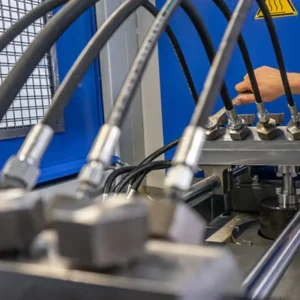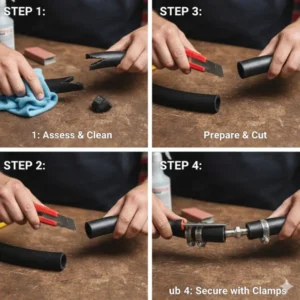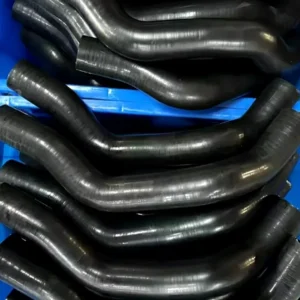Maintaining the integrity of your rubber hoses is crucial for ensuring peak performance and longevity, whether they are used for industrial applications, in the garden, or in your vehicle’s engine bay. Over time, rubber hoses accumulate dirt, grime, and internal residues that can lead to clogs and material degradation.
This guide provides simple, effective, step-by-step methods to thoroughly clean your rubber hoses, both inside and out. Learning to clean your hoses correctly prevents premature failure, maintains optimal flow rates, and saves you the expense of frequent replacements, keeping your system running smoothly.
When to Clean Rubber Hoses?
Understanding the correct timing for cleaning rubber hoses is a crucial component of preventative maintenance, ensuring they remain in optimal working condition. Cleaning frequency depends largely on the hose’s application, the medium it transports, and the environment it operates within.
- After Exposure to Harsh Chemicals Hoses used to transfer corrosive chemicals, solvents, or abrasive materials must be cleaned immediately after use. This critical flushing prevents residual substances from chemically degrading the internal lining or hardening the rubber, which shortens the hose’s overall service life and maintains safety.
- Before Extended Storage Always clean and completely dry hoses before putting them into storage for a long period, especially if they will be coiled. Removing all internal moisture, residue, and external dirt prevents the growth of mold or mildew, avoids chemical contamination, and ensures the hose is ready for immediate use later.
- Upon Visible External Contamination If the outer cover shows obvious signs of heavy dirt, mud, oil, or grease accumulation, it is time for a thorough wash. External buildup can trap moisture and accelerate the degradation of the rubber cover, making it brittle and vulnerable to cracks and cuts.
- When Flow or Performance is Reduced A noticeable drop in fluid flow rate or pump efficiency often signals internal buildup or residue clogging. In these cases, a deep internal flush or scrubbing is required to clear blockages, restore the full internal diameter, and ensure the system operates at its designed capacity.
How to Clean a Rubber Hose?
A clean rubber hose is essential for reliable performance and longevity, preventing internal blockages and external material degradation. We will guide you through a comprehensive, step-by-step process using gentle methods to clean both the interior and exterior surfaces effectively and safely.
Step 1: Disconnect and Drain the Hose
Before any cleaning begins, ensure the hose is completely disconnected from all sources, including faucets, pumps, or machinery. This necessary safety precaution prevents accidental flow and allows you full access to both end fittings for better cleaning.
Once disconnected, fully drain any residual fluids, water, or media from the hose. Hold both ends up to allow gravity to clear the line, then coil the hose over your arm or a rail, working from one end to the other to push out all remaining contents.
Step 2: Wash the Exterior Surface
Prepare a cleaning solution using warm water and a mild dish soap or a dedicated rubber cleaner in a bucket. Avoid harsh chemicals or industrial degreasers, which can dry out and damage the rubber compound over time, leading to premature cracking.
Using a soft cloth or a non-abrasive brush, gently scrub the entire outer surface of the hose. Pay special attention to areas with heavy dirt, oil, or mildew buildup, but avoid aggressive scrubbing that could compromise the outer protective layer.
Step 3: Flush the Interior with Water
Reattach the hose to a clean water source, such as a utility sink or outdoor spigot. Run clean, high-pressure water through the full length of the hose for several minutes to loosen and flush out any loose internal debris, particles, or sediment.
For hoses used to convey specialized fluids, reverse the flow direction a few times to ensure thorough rinsing. This action helps dislodge any stubborn material clinging to the inner wall, making sure the line is clear and restoring the optimal flow capacity.
Step 4: Use a Mild Internal Cleaning Solution
For a deeper clean, especially for hoses carrying viscous liquids, prepare a solution of water and mild soap, or a compatible cleaner recommended by the manufacturer. Pour or pump this solution into the hose and let it soak for several minutes.
Alternatively, for smaller hoses, you can thread a soft sponge or cloth swab attached to a piece of string through the line. Pull the saturated swab back and forth to scrub the interior walls gently, breaking down any sticky residue or film.
Step 5: Rinse Thoroughly to Remove Soap
After cleaning the interior, it is critical to rinse the hose with clean, clear water until absolutely all traces of the soap or cleaning solution are eliminated. Leftover residue can chemically react with the rubber or the medium later transported, causing damage.
Continue flushing for several minutes, allowing the water to run clear and bubble-free from the discharge end. This step is non-negotiable for food-grade or sensitive application hoses to prevent any chemical taste or contamination transferring to the fluid.
Step 6: Ensure Complete Drying
Allow the hose to air-dry completely before coiling or storing it. Hang the hose vertically or drape it over a horizontal support in a dry, well-ventilated area, avoiding direct sunlight which can degrade the rubber.
Ensure there is zero residual moisture trapped inside, as this promotes the growth of mold or bacteria, especially in hoses used for water or food media. Proper drying protects the hose from internal biological degradation during its storage period.
Methods to Clean a Flexible Rubber Hose
Effective cleaning methods are vital for maintaining the flexibility and internal integrity of rubber hoses, preventing clogs and material breakdown. The approach you choose should be tailored to the hose’s size and what media it typically carries, ensuring both the inner and outer surfaces are completely sanitized.
- For External Grime: Use Soapy Water and a Soft BrushA simple yet effective method is washing the exterior with a mixture of warm water and mild dish detergent. Use a soft-bristle brush or sponge to gently scrub off surface dirt, oil, and mud. Rinse thoroughly to ensure no soap residue remains on the rubber surface.
- For Internal Residue: Water and Air FlushingFlush the inside of the hose with a continuous stream of high-pressure water to dislodge loose debris. For heavy-duty cleaning, you can also connect an air compressor to one end and gently blow bursts of air through the hose, which helps push out stubborn particles.
- For Small Hoses: The String-and-Swab TechniqueFor narrow-diameter hoses, tie a small piece of cloth or foam to a long string, saturate it with a mild cleaning solution, and pull it through the hose. This manually scrubs the interior walls, effectively removing sticky residues that water alone may not clear easily.
- For Sterilization: Utilize Steam or Chemical SoakingIn food-grade or sanitary applications, sterilization is often necessary. Steam cleaning (if rated for the hose) or soaking the hose in a diluted, compatible sanitizer solution, such as a vinegar mixture, kills bacteria. Always follow the soaking with a complete, fresh water rinse.
Conclusion
A clean rubber hose is an efficient and durable rubber hose. By following the simple washing, flushing, and drying steps outlined in this guide, you actively prevent the buildup of contaminants that cause premature cracking and failure. Regular maintenance and proper cleaning ensure that your hoses deliver reliable, consistent performance for years, protecting your investment and minimizing costly downtime.
Remember that even the highest quality rubber hoses require consistent care to maximize their lifespan and maintain safety standards. Make this cleaning routine a regular part of your equipment maintenance schedule. A small effort in proactive cleaning translates into massive savings on replacement costs and ensures that your operations remain uninterrupted by hose failure.
For all your industrial, hydraulic, or custom-application needs, turn to reliable manufacturing. When it’s time to replace or upgrade your inventory, ensure you are investing in quality by choosing to get wholesale rubber hoses from our Gushan Rubber. We offer a durable and extensive selection to meet every demanding specification.




